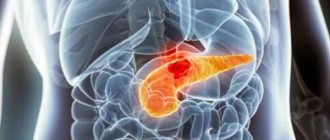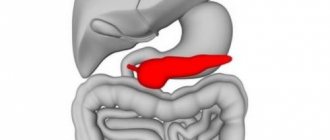Sometimes gastroenterologists use the term pancreatic dysfunction. But what does this mean and does this diagnosis have anything to do with pancreatitis? Dysfunction implies a disorder in the functions of an organ. In relation to the pancreas, this may be an increase in its functions or, conversely, insufficiency. Often the concept of dysfunction is used in parallel with the diagnosis of “chronic pancreatitis”. This condition is not an independent disease; it refers to a set of symptoms that indicate that the pancreas is not working properly.
Symptoms of pathology
First of all, patients with pancreatic dysfunction experience indigestion, which may be accompanied by nausea, sometimes vomiting, belching, heartburn and rumbling in the abdomen. In this case, the stool may be mushy several times a day. It may contain remnants of undigested food. Among other things, the stool may be accompanied by an unpleasant odor. Usually such a chair leaves greasy marks on the toilet. Also, patients with this disorder may experience alternating constipation and diarrhea.
Diet food
To normalize the functioning of the pancreas, you need to adhere to a certain diet. First, observe a short fast for 24 hours, and then eat according to diet No. 5. The food should not be too hot.
You need to eat 4-6 times a day and consume small amounts of food at one time. At the same time, there should be a calm atmosphere, the person should not rush anywhere. Every piece of food is chewed carefully.
List of permitted products:
- meat – chicken, turkey, rabbit, veal;
- fish - low-fat varieties, as well as crayfish and shrimp;
- fat – sunflower, olive, corn oil;
- dairy products – low-fat cottage cheese, kefir, yogurt, yogurt; low-fat cheese; milk in small quantities, fat content 2.5;
- egg – one or two per week, cooked as an omelet in the oven;
- fruits and vegetables - baked zucchini, carrots, apples, melons, pumpkin, bananas, as well as compotes made from them; apricots, peaches;
- potatoes – baked, boiled or mashed;
- bread – white, not today’s bread, can be cooked in a toaster;
- porridge – rice, oatmeal, semolina, buckwheat, possibly with milk;
- sweets - sponge cake, fat-free cake, fruit pies, cookies with oatmeal, honey, small quantities of caramels;
- drinks – tea, still water, weak coffee with milk, jelly.
We also recommend viewing: Symptoms and treatment methods for pancreatic inflammation
Important. All dishes must be boiled, stewed, baked.
What should be excluded from the diet if you have pancreatic dysfunction:
- meat - lamb, pork, duck, goose, fatty meats, as well as all types of sausages;
- fish – all fatty varieties, as well as caviar;
- fat – lard, animal fat, margarine, butter, mayonnaise;
- dairy products - all fatty types of dairy products, as well as large amounts of milk;
- egg – fried, boiled;
- vegetables and fruits - cabbage in any form, radishes, radishes, sorrel mushrooms, legumes;
- potatoes – fried, fatty;
- bread – black, with bran, as well as today’s bread;
- porridge – pearl barley, wheat;
- sweets – cream sweets, fresh pastries, chocolate products, ice cream;
- drinks – alcohol, carbonated drinks, strong coffee, cocoa.
Important. Anything fried in oil or over a fire is prohibited for consumption.
Painful sensations with this pathology
Another symptom of pancreatic dysfunction is pain in the area of the latter - in the left hypochondrium. The pain usually radiates to the lumbar region. Painful sensations can have a clear relationship with dietary errors. Usually the pain intensifies after eating fatty, fried, spicy, smoked and pickled foods. In addition, many patients report increased pain due to psychoemotional stress. Another symptom of this disorder is weight loss, which occurs with prolonged disruption of the absorption of nutrients and their digestion.
Symptoms and treatment of pancreatic dysfunction are interrelated.
Symptoms of pancreas failure
During dynamic monitoring of the course of a sick person’s condition, an increase in temperature to subfebrile levels is determined.
Additional symptoms by which you can determine the failure of the pancreas and not confuse them with the manifestation of other diseases:
- diarrhea;
- increased gag reflex;
- tachycardia;
- sudden attacks of fever and sweating;
- yellowing of the skin and whites of the eyes.
It is rare, but it happens that a person himself somehow survived an acute form of pancreatitis, and the disease became chronic. This happens if at an early stage of the disease the pain symptom did not manifest itself in full force, there was only vomiting and upset stool, and the person could mistake the attack for a normal stomach upset.
Untreated pancreatitis takes a chronic form and worsens periodically, especially when the diet is violated, after a large feast or an entertainment party with a lot of alcohol. The chronic form of pancreatitis is characterized by a feeling of enlargement of the pancreas, then there is a feeling of fullness in the ribs, and breathing becomes difficult.
When the pancreas fails, the main symptom is, of course, severe pain, which can be girdling and even radiate to the lower back. Acute pain is characterized by a precise localization - this is the upper abdomen, around the navel. The intensity and duration of pain depends on the level of development of the inflammatory process. The most acute pain, up to severe shock, is characteristic of the acute form of pancreatitis.
When the pain is girdling, the pain is so severe that it can easily be confused with manifestations of osteochondrosis, cholecystitis, pyelonephritis, and appendicitis. It is not difficult to confuse the failure of the pancreas, because with all the strength of the pain, they are quite varied - dull pulling, sharp cutting, strong spasms, or pain of medium intensity continuously lasting for several days.
What to do if the pancreas fails?
When it becomes clear that the pain is associated with pancreatic failure, you can no longer do without a doctor. It’s good if you still have the strength to go to the appointment yourself. Most often you have to call a therapist at home, or go to an ambulance. With an acute form of the disease, immediate hospitalization is recommended, including surgical intervention. With exacerbation of chronic pancreatitis, you can stop at outpatient treatment.
In any case, the first actions in case of pancreatic failure are taking antispasmodics, painkillers, anti-inflammatory drugs, switching to a “starvation” diet, and alkaline drinking. When laboratory confirmation of abnormalities in sugar levels occurs, the patient is prescribed insulin, along with medications containing enzymes.
One step that should be taken immediately is to go on a strict diet. This will involve significant changes in lifestyle, but for the sake of health and life it is worth making such sacrifices. And if you don’t consider dietary dishes a special sacrifice, then you can gradually accustom the whole family to a diet, that is, to a healthy, nutritious diet.
Causes of pathology
The most common cause of pancreatic dysfunction is the presence of slowly progressive chronic pancreatitis in the patient, which develops as an independent disease. Dysfunction of this organ may also be a direct response to the following factors:
- Irregular consumption of food with a predominance of fatty, fried and spicy foods.
- Deficiency of vitamins and protein supplied from food.
- Untreated pathologies of the hepatobiliary system. For example, this may be chronic cholecystitis along with cholelithiasis, biliary dyskinesia and choledochopancreatic reflux, in which bile is refluxed into the large pancreatic ducts.
- Excessive abuse of alcoholic beverages.
- The presence of gastritis, duodenitis, gastric ulcer and intestinal ulcer in a person.
If the patient has a tendency to diseases of the digestive system, then dysfunction of the liver and pancreas will certainly manifest themselves, so such patients need to be careful in terms of nutrition, carefully regulating their diet choices. It is extremely important to promptly pay attention to any digestive disorder and it is imperative to find out the causes. You need to be especially careful when drinking alcohol, as this is the most important damaging factor for the pancreas.
Diagnosis of this pathology
Before starting treatment for pancreatic dysfunction, it is necessary to accurately establish the diagnosis. For these purposes, the following research techniques are used:
- Analysis of the patient's history and complaints.
- An examination during which the doctor identifies symptoms specific to pancreatic dysfunction, determining the general condition of the patient.
- Carrying out a biochemical blood test.
- Taking a urine test for alpha-amylase.
- Carrying out an ultrasound examination of the pancreas. It is this study that displays the picture of changes in gland tissue.
Symptoms of inflammation
Signs can be very diverse. This or that syndrome may not always indicate a pathology of the gland. Therefore, if clinical complaints appear, the patient should consult a doctor to clarify the diagnosis and prescribe the necessary treatment.
1. Acute pain in the pancreas. The organ is located on the left in the upper abdomen. Therefore, pain syndrome spreads there. May begin in the epigastric region.
At first, the pain is aching and periodic. If the pathology progresses to more serious stages, an attack may occur. It is characterized by girdling, burning pain of a paroxysmal nature.
At the height of the attack, nausea and vomiting occur. It can radiate to the back, shoulder blade, neck, head, kidneys on the left side. This is all typical for acute pancreatitis.
During oncological processes, heaviness and a feeling of pressure are felt at the site of the gland projection. This occurs due to damage to the organ capsule.
2. Pancreatic disorder. This group includes digestive changes and hormonal disorders.
- Nausea due to pancreatic disease. Nausea occurs due to obstruction of the patency and outflow of juice from the pancreatic canal. The phenomenon of intoxication occurs. It may be present for a long time, or may go away after vomiting. Against the background of pain, nausea intensifies. As the pain subsides, it disappears. It can be eliminated with medication using antiemetics.
- Diarrhea due to pancreatic pathology. Caused by a decrease in enzyme activity. Food enters the intestines, but a sufficient amount of enzymatic compounds is not released. This provokes fermentation and malabsorption processes. Diarrhea appears. It is characterized by abundant quantity. Looks greasy and shiny. Doesn't wash off well. Has a foul odor. Contains impurities of undigested foods. Loose stools happen up to 5 times a day.
- Vomit. It does not happen as often as the first two symptoms. Occurs in advanced stages of the disease. Reflex vomiting is also observed during the manifestation of intoxication. Often accompanies a pancreatic attack. After vomiting, relief comes.
- Hypovitaminosis and anemia. They are characterized by dry skin, brittle nails, gingival bleeding, and hemorrhagic manifestations.
When a secondary infection or complications occur, other signs may appear:
- Gastrointestinal bleeding;
- Capsule rupture;
- Hepatosplenomegaly is a compensatory increase in the size of the liver and spleen;
- Ascites is an accumulation of fluid in the abdominal cavity;
- Peritonitis is inflammation of the peritoneum. Very life threatening;
- Sepsis is a generalized infection, the entry of microbes into the blood and their transfer to other organs;
- Hypoglycemic or hyperglycemic coma.
Therefore, it is very important to begin treatment for the disease as early as possible.
Symptoms of a pancreatic attack
An attack is an acute, cramping pain that occurs in a number of pathologies. Appears due to impaired outflow of pancreatic juice, blockage of the pancreatic duct, stretching and rupture of the capsule.
Characteristic of diseases: pancreatitis in the acute phase, pancreatic stones, pancreatic necrosis, malignant neoplasms.
Symptoms of an attack:
- Severe, intense, cramping, girdling pain, which is difficult to eliminate with analgesics. Irradiates to other organs.
- Unbearable nausea, bitterness in the mouth.
- At the height of pain, vomiting bile or gastric juice.
- Severe diarrhea.
- Increased body temperature.
- Increased heart rate and increased blood pressure.
- Pale skin. Drops of cold sweat appear on the body.
- The patient has a feeling of fear of death.
This condition can only be treated in a hospital under the supervision of a doctor. Intensive therapy is possible.
Treatment of the disease
The first step in treatment for signs of pancreatic dysfunction is therapeutic fasting. Thus, during the treatment process, with all available means it is necessary to ensure absolute rest for the gland.
Among the medications, drugs are prescribed that reduce gastric secretion, for example, during the treatment process, patients are prescribed Omez along with Pantoprazole, Ranitidine and Kvamatel. The use of one of these medications is extremely necessary for this disease, since gastric juice is one of the main stimulants of pancreatic secretion.
Treatment of this pathology with mineral waters
During periods of remission, patients suffering from pancreatic dysfunction are prescribed treatment at drinking resorts such as Essentuki, Zheleznovodsk and Kislovodsk. Many doctors, when the first symptoms of deterioration in pancreatic function appear, recommend drinking heated mineral water (it is important that the water is still). Essentuki, Borjomi and Narzan are ideal for this. During treatment, you should take up to one and a half liters per day.
Summarize
Pancreatic dysfunction is a disease that needs to be treated with special attention. If digestive problems occur, there is no need to wait or self-medicate, you should immediately contact a specialist.
We also recommend viewing: Drugs for the prevention of pancreas
The gastroenterologist will prescribe treatment and a diet that must be followed strictly. Be very careful about suspicious symptoms in children.
If dysfunction is not treated, serious complications and poor health of the body can result. Compliance with the prescribed treatment and diet will lead to complete recovery.
Prevention of pathology
In order to avoid pancreatic dysfunction, it is necessary to diagnose and treat pathologies that arise in the digestive system in time. Particular attention should be paid to rational nutrition. It is extremely important not to overeat, and in addition, avoid fatty, fried and smoked foods.
Eating fresh vegetables and fruits along with taking vitamin complexes will certainly help to significantly enrich your diet with useful components. You shouldn’t rush while eating; you need to chew your food properly, following your diet. It is best to eat small, frequent meals. It is worth noting that this rule helps to avoid many diseases of the digestive system. This diet is also the most optimal for the pancreas, which is always at risk at the slightest error in food.
Prevention of dysfunctions
How to restore health after a course of medications or with mild dysfunctions? Gland pathologies can be prevented if you follow the minimum rules of a healthy lifestyle.
Gastroenterologists strictly prohibit non-compliance with the diet.
To maintain the pancreas and other digestive organs it is necessary:
- Eat an extremely balanced diet. You cannot replace your daily diet with one cake or put yourself on an unthinkable diet. At least a minimum amount of vital proteins, fats and carbohydrates must be supplied to the body, and the volumes must be measured. A suitable preventative diet can be prescribed by the nutritionist responsible for the treatment or examination.
- Follow a meal schedule. The diet must include breakfast, lunch, dinner, and at least one snack. It is ideal to eat food every 3-4 hours, when the previous meal has already been fully absorbed, and gastric juices have not yet had time to damage the walls of the empty stomach. For breakfast, a person should receive a maximum of carbohydrates and fats, then the remainder and proteins are evenly distributed over other meals.
- Avoid alcohol. Alcoholic drinks disrupt the functioning of the gland, burn the gastrointestinal mucosa, leading to heartburn and bloating. Complete abstinence is the optimal preventive measure, but if it is not possible to completely eliminate alcohol, you should at least reduce it to a minimum (no more than once a week) while treatment lasts.
- Avoid foods that are too fatty and that have been heavily fried in oil. With this processing, food loses essential vitamin elements.
- Avoid stress while the body is recovering, try to spend more time with your family and on vacation. Maintain a sleep schedule.
Important information: How to diagnose pancreatic cancer at an early stage
Physical activity for this disease
Strong physical activity, along with sports or gymnastics, helps people relieve mental stress, while maintaining tone and normalizing metabolism. Pancreatic dysfunction is a disease that requires increased attention to the condition of your entire body as a whole. Any disturbances in the functioning of the digestive system require mandatory consultation with a doctor and careful diagnosis. Following a diet along with following the gastroenterologist’s prescriptions will necessarily lead to the normalization of the general condition.
Parents should be especially attentive to the appearance of pancreatic dysfunction in a child. Untreated pathology of such an important organ can lead to extremely serious complications, and, in addition, to a significant deterioration in the baby’s quality of life.
Causes of dysfunction
The cause of the disorder is most often a person’s unhealthy eating behavior. Constantly eating junk food, eating fatty foods or cooking only fried foods plays a negative role. This causes disruption of the entire body, not just the pancreas. Whenever you consume junk food, it is important to observe the measure, and then carry out fasting days. But most people don't do this, resulting in pancreatitis or other abnormalities.
According to the World Health Organization, the following factors (except those mentioned) are the causes of chronic pancreatic malfunctions:
- binge eating;
- alcohol abuse, both binge-type and regular;
- imbalance of nutrients in the daily diet (proteins, fats and carbohydrates);
- vitamin deficiency due to insufficient consumption of fruits and vegetables;
- lack of an approximate diet;
- ailments of the gastric region;
- disturbances in the functioning of the duodenum;
- stressful situations;
- the presence of formations in the gallbladder, its ducts and in the gland itself.
The bulk of all the prerequisites are associated with a violation of the diet and its balance. Therefore, preventive methods are always aimed at adjusting the timing of feeding and the content of the diet.
In order for gland dysfunction to disappear, it is necessary to combine prevention and therapy.
A specialist cannot accurately characterize the disease without finding out the reason why the body disrupted its own function. The first thing a patient who discovers a disorder of the pancreas should do is contact a gastroenterologist for advice and diagnosis of the disease. The specialist will prescribe the appropriate treatment.
Important information: Can a person live without a pancreas?











